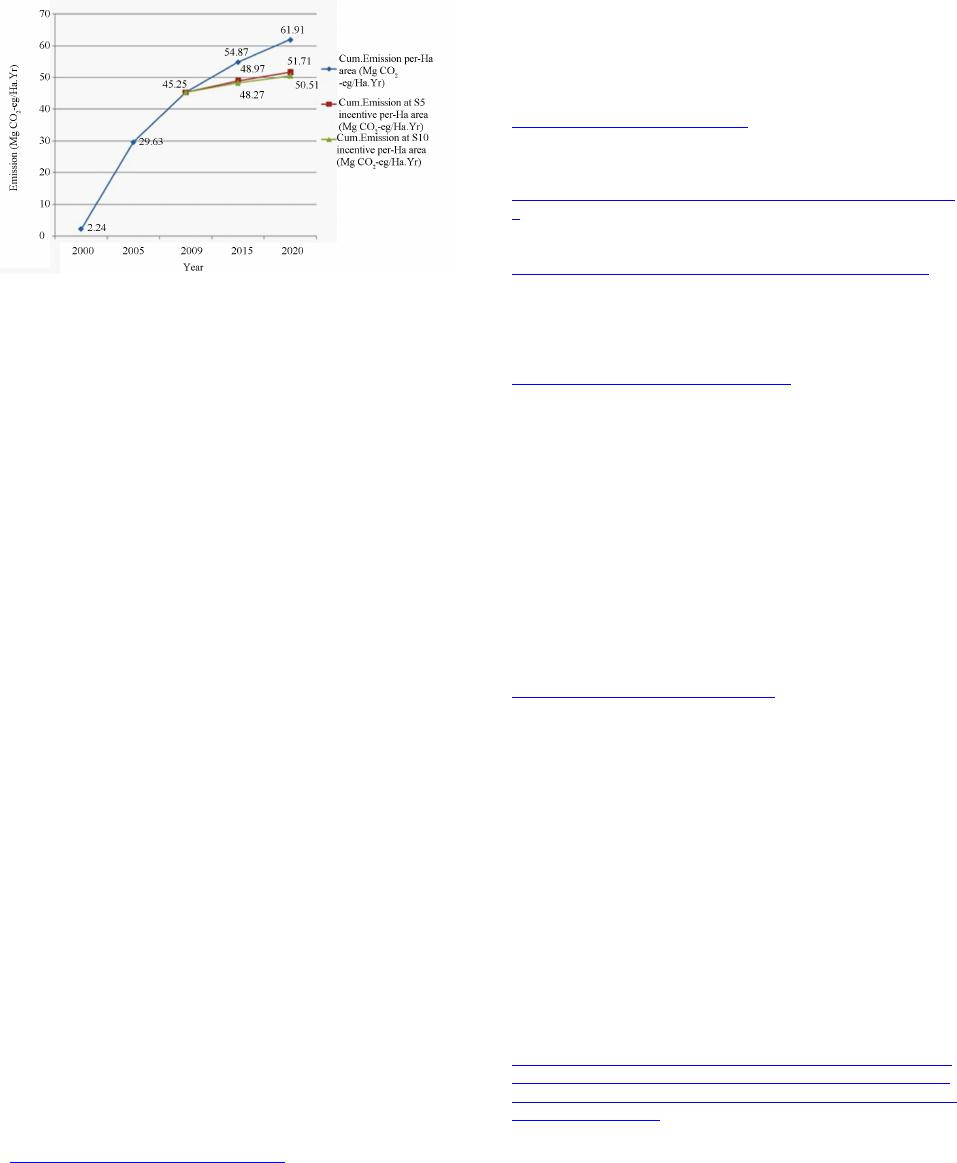
S. SUYANTO ET AL.
Figure 8.
Potential Emission reduction at $5 and $10 thre s hold.
Conclusion
The ex-ante analysis in predicting the potential for future
emission reduction through REDD+/REALU approaches shows
that t he cumulative emission of Tanjabar in 2020 is estimated at
61.91 Mg CO2-eq/Ha.Year. Based on retrospective analysis,
there is a potential for 16% emission reduction using $5/ton
CO2-eq incentive. However, if the the threshold is increased to
$10, the amount of reduced emission does not change much.
Large proportion of emission in Tanjabar cannot be com-
pensated through incentive mechanism since it will result in
large opportunity cost. This is a good example of many areas in
Indonesia where development activity, although it produces
large amount of emission, also has significant amount of prof-
itability that is important for local development. Insignificant
amount of potentially avoided future emission through incen-
tive mechanism indicates opportunities to derive policy inter-
vention toward low emission development strategy by con-
serving high carbon stock areas and focused development on
land with high carbon-high profitability through participative
approach such as land use planning.
Acknowledgemen ts
This publication is supported by the NORAD-funded project,
“Reducing Emissions from All Land Uses (REALU) and
CGIAR Research Progra m on Forests, Trees and Agrofore stry—
Landscape Management (CRP-6.3). The authors would like to
thank the communities of Tanjung Jabung Barat district for
their generous hospitality and their patient participation in the
surveys and authors thank Robert Finlayson, ICRAF Regional
Communications Specialist for English editing.
REFERENCES
Böttcher, H., Eisbrenner, K., Fritz, S., Kindermann, G., Kraxner, F.,
McCallum, I., & Obersteiner, M. (2009). An assessment of monitor-
ing requirements and costs of “Reduced Emissions from Deforesta-
tion and Degradation”. Carbon Balance and Management, 4, 7.
http://www.cbmjournal.com/content/4/1/7/
BPS (2011). Tanjung Jabung Barat Dalam Angka 2010. Jambi: Badan
Pusat Statistik Kabupaten Tanjung Jabung Barat.
Gittinger, J. P. (1982). Economic analysis of agricultural project (2nd
ed.). Baltimore: John Hopkins University Press.
Grieg-Gran, M. (2008). The cost of avoiding deforestation. London:
International Institute for Environment and Development (IIED).
http://pubs.iied.org/pdfs/G02290.pdf
Huettner, M. (2011). Risks and opportunities of REDD+ implementa-
tion for environmental integrity and socio-economic compatibility.
Environmental Science, 15, 4-12.
http://www.sciencedirect.com/science/article/pii/S146290111100152
3
Harja, D., Dewi, S., Van Noordwijk, M., Ekadinata, A., & Rahmanulloh,
A. (2011). REDD Abacus SP. User Manual and Software.
http://www.worldagroforestry.org/sea/projects/allreddi/softwares
Kindermann, G., Obersteiner, M., Sohngen, B., Sathaye, J., Andrasko,
K., Rametsteiner, E., Schlamadinger, B., Wunder, S., & Beach, R.
(2008). Global cost estimates of reducing carbon emissions through
avoided deforestation. Proceedings of the National Academy of
Sciences of the United States of America, 105, 10302-10307.
http://dx.doi.org/10.1073/pnas.0710616105
Kindermann, G., Obersteiner, M., Rametsteiner, E., & McCallum, I.
(2006). Predicting the deforestation-trend under different carbon-
prices. Carbon Balance and Management, 17.
Mollicone, D., Freibauer, A., Schulze, E. D., Braatz, S., Grassi, G., &
Federici, S. (2006). Elements for the expected mechanisms on “re-
duced emissions from deforestation and degradation (REDD)” under
UNFCCC. Environmental Research Letters, 2, 7.
Pagiola, S., & Bosquet, B. (2009). Estimating the costs of REDD+ at
country level. Version 2.2, Washington, DC: Forest Carbon Partner-
ship Facility, World Bank.
Peters-Stanley, M., & Hamilton, K. (2012). Developing Dimension:
State of the voluntary carbon market 2012. Washington, DC: The
Ecosystem Marketplace and Bloomberg New Energy Finance.
Sofiyuddin, M., Rahmanulloh, A., & Suyanto, S. (2012). Assessment of
profitability of land use systems in Tanjung Jabung Barat District,
Jambi Provi nce, Indonesia. O pen Journal of Forest r y, 2, 252-256.
http://dx.doi.org/10.4236/ojf.2012.24031
Sohngen, B., & Beach, R.H. (2006). Avoided deforestation as a green-
house gas mitigation tool: Economic issues for consideration (p. 40).
Columbus: The Ohio State University.
Rahayu, S., Khasanah, N., & Asmawan, T. (2011). Above and
belowground carbon stock. In A. Widayati, S. Suyanto, & M. van
Noordwijk (Eds.), Towards reduced emissions in a high-stake dis-
trict REALU project design for Tanjung Jabung Barat (Tanjabar),
Jambi, Indonesia (pp. 59-73). Project Report, Bogor: World Agrofor-
estry Centre—ICRAF Southeast Asia.
Swallow, B., Van Noordwijk, M., Dewi, S., Murdiyarso, D., White, D.,
Gockowski, J., Hyman, G., Budidarsono, S., Robiglio, V., Meadu, V.,
Ekadinata, A., Agus, F., Hairiah, K., Mbile, P. N., Sonwa, D. J., &
Weise, S. (2007). Opportunities for avoided deforestation with sus-
tainable benefits. An interim report by the ASB partnership for the
tropical forest margins. Nairobi: ASB Partnership for the Tropical
Forest Margins.
White, D., & Minang, P. (2011). Estimating the opportunity costs of
REDD+. A traini ng manual. Washington, DC: World Bank Institute.
World Bank (2012). State and trends of carbon market report 2012.
http://web.worldbank.org/WBSITE/EXTERNAL/TOPICS/ENVIRO
NMENT/EXTCARBONFINANCE/0,,contentMDK:23206428~men
uPK:5575595~pagePK:64168445~piPK:64168309~theSitePK:41258
53~isCURL:Y,00.html
OPEN ACCESS
90